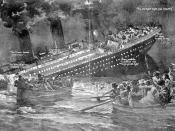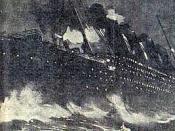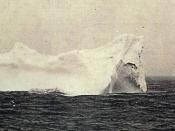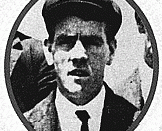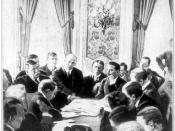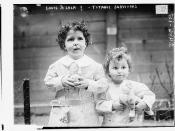Great Disaster in 1912 In April of 1912, The New york Times wrote an article about the "great modern liners ," with their new technology and safety precations, saying "that even after the most violent shock they will be kept afloat" ("Titanic" 12). The disaster of the magnificant ship, the Titanic, a ship of great size and magnitude gained worldwide attention because the disaster could have been avioded.
Many factors of ignored precations contributed to the sinking of the great ship. The ship collided with an iceberg,late on the evening of April 14. The iceberg struck the right bow of the Titanic, leaving a deep cut in the ship's steel walls. The titanic, equipped with the latest construction specialties from around the world, began to take on water. new technologies such as the heavy steel doors and air compressed door frames that shunned water when closed, were thought to keep the water from entering levels of the ship.
Earlier that evening, records claim Captian Smith ordered the ship full throttle, reaching high speeds of 22 knots. The speed of the ship wouldn't allow for a turn to pass the iceberg without contact. Although it was said the watchman spotted and reported the iceberg before contact, the Captian on duty proceeded full throttle. The intention of this furious speed was to reach New York a day before schedual to impress the world with the ships incerdible technologies.
When the first sight of the iceburg was reported, crew members on duty believed the ship would graze past the iceburg leaving only the ice broken and scattered. When news of water entering the ship in mass quantiities, Captian Smith was quick to send destress signals in the air, hoping rescue attempts would be made. Although many ships were said to have been within a short distance from the sinking ship no rescue attempts were made. Carpathia, a ship near by recieved morris code that the ship was sinking and raced through the night to the spot of terror. When Carpathia arrived early on the morning of april 15, passangers were shocked by the terrible truth and surviving passangers of the Titanic were brought aboard the Carpathia. Passangers couldn't belive the fate of such a magnificant ship.
The Titanic gained worldwide intrest because of the magnitude of its size and luctory. The building of the great ship began March 31,1909. Parts and Pieces of the great ship came from all over the world to create the world's finest ship. Construction of the Titanic and its sister ship the Olympic created jobs for nearly 15000 construction workers. Among intellegent minds behind the construction of the Titanic, were white star lines finest desiners, J. Bruce Ismay and Lord William James Pirrie. Pirrie owned one of the worlds finest shipbuilding firms, Harland and Wolff. The two met over dinner, with decisive plans to build three of the worlds greatest ships known to man. These ships were to be suprisingly fast and enormous in size. Titanic was equipped with three steel propellers fueled by the burning coal. To restrain the ship were three 16 ton anchors in which were carried by many horses through the streets of Belfast to ammuse onlookers. Titanic carried twenty nine boilers, each 15 feet in diameter, allowing the ship to burn large amounts of coal and produce high speeds. Titanic 882 feet long and 60 feet tall. The great ship allowed eight decks leaving only two to engines. She was equipped with the latest telephone system avalible, making the ship seem a hotel on the water. Passangers claim the Titanic "the achievement of the age, the largest and finest product of the stupendous skill of the first maritime nation of the world" (timelife36). Along with speed and size, Pirrie demanded luctury a must. First class passangers were surrounded by the most lavish decorating, including the famous grand staircase. Along with beautiful decorations, came first class work out rooms and the first ever on deck swimming pools. the ship traveling at 22 knots struck an iceberg allowing only ten seconds of contact but 300 feet of damage. Captian Smith ordered all watertight compartments to be closed,shunning water from entering the compartments of the ship. Although the compartments were shut quickly, water rushed into compartments five and six overpowering the displacement. The five steel layers of the ships body had been gashed open. Quinn describes the water overpowering the ship "while bad news flowed into the bridge, water flowed into third class accomidations on G deck. Unlike other passangers who gradually learned of the titanic's problems, steerage passangers in the bow were informed firsthand, and in an abrupt way" (Quinn88).
Obediant orders and proper safety equipment and precations might have changed the fate of the Titanic. It was said Captian Smith ordered the ship to directly collide with the iceberg allowing the sharp corner of the bow to break through the ice and leave little damage to the ship. Other accounts claim Captian Smith was awakend by the strike of the iceberg and gaind knowledege of the iceberg after contact. records indicate radio operators recieved knowledge of the icebergs before the ship entered the dangerous areas. the operator on duty at the time was busy sending private massages to citizens of the land based Marconi station at Cape Race. The iceberg warning was set aside while the operator focused on the volume of private messages. This safety warning ignored, would doom the ship to the depths of the atlantic forever. To better navigate and ensure the safety of the ship and its passangers a crew of three men sit in the crow's nest looking over the ocean infront of the ship, using binoculars to see distant dangers. On the night of the impact, the binoculars that should have been in the crow's nest were missing, relying soly on the sight of the naked eye. When watchman Fredrick Fleet made out the blurred vision of the large iceburg, it was too late. On April 10,1912 "The Board of Trade inspection of muster lists and safety devices completed the inspection of safety equipment on the great ship"(6). Although thourougly inspected, the Titanic carried only 15 lifeboats for the 3,547 passangers desined to carry. This was the greatest safety mistake made by inspection. Overwhelmed by the size and magnitude of the ship, passangers did not notice the few numbers in lifeboats. The thought of the Titanic sinking never crossed the minnds of passangers, since "unsinkable, [the word] that found its way into newspaper headlines" (timelife12) Of the 2,228 passangers and crew aboard only 705 were rescued after the Titanic fell to the bottom of the ocean. The 15 lifeboats lowered to the ocean were overcrowded with women and children, leaving 1,523 men,women and children to perish with the great ship.
Although we hear the story and read the books, "it was sad when the great ship went down,......and the eighty-eight years since, the sinking of the Titanic has continued to facinate the human mind and tug the heart like few other events in history" (Cameron 1).
